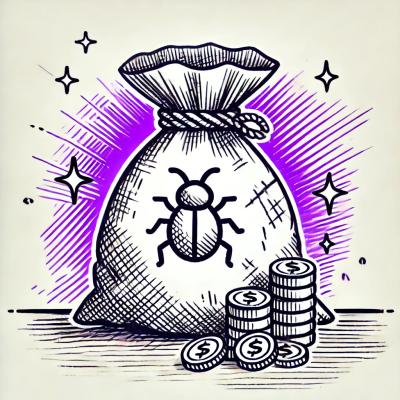
Research
Security News
Malicious npm Packages Use Telegram to Exfiltrate BullX Credentials
Socket uncovers an npm Trojan stealing crypto wallets and BullX credentials via obfuscated code and Telegram exfiltration.
gherkin-assembler
Advanced tools
It allows to convert Gherkin AST to feature file string.
objectToAST(document)The objectToAST API method converts the given Gherkin object into GherkinDocument object.
A complete sample Gherkin object can be found here: Complete Gherkin object.
Params:
{Object} documet - a single Gherkin objectReturns: {GherkinDocument}
format(document, options)The format API method formats the given Gherkin Document(s) to string (which could be written out to feature file(s)).
Params:
{GherkinDocument|Array<GherkinDocument>} document - a single or multiple Gherkin Documents given in it's AST model.{AssemblerConfig} options - options to set attributes of formatting.Returns: {string|Array<string>}
'use strict';
const fs = require('fs');
const assembler = require('gherkin-assembler');
const document = assembler.objectToAST(require('./login.ast.json'));
fs.writeFileSync('./login.feature', assembler.format(document), 'utf8');
AssemblerConfigBy passing an AssemblerConfig object to format method (or other Ast type methods where it's applicable) it can be set, how feature file text is rendered.
| Option | Description | Default |
|---|---|---|
oneTagPerLine | Should tags rendered separately, one by line? | false, i.e. all tag of a scenario, feature, etc will be rendered in the same line |
separateStepGroups | Should step groups (when-then) be separated? | false |
compact | Should empty lines be skipped, removed from the result? | false, i.e. there will be empty lines in appropriate places |
lineBreak | The line break character(s). | \n, i.e. it uses Unix line break, to set Windows style, set \r\n |
indentation | The indentation character(s). | ' ', i.e. it uses two space character to add indentation where it's appropriate |
The API provides types to be able to handle different parts of Gherkin feature files.
'use strict';
const {AST} = require('gherkin-assembler');
console.log(Object.keys(AST));
// Background,...,Feature,GherkinDocument,...,Tag
GherkinDocumentModel of a complete Gherkin document, i.e. feature file.
{Feature} feature - The feature which this document contains.new GherkinDocument() : GherkinDocument - Creates a new instance.{GherkinDocument}.toString({AssemblerConfig} [options]) : string - Converts the document to string, i.e. formats it.{GherkinDocument}.clone() : GherkinDocument - Clones the document.GherkinDocumnet.parse({Object} object) : GherkinDocument - Parses the given GherkinDocument object to a GherkinDocument.FeatureModel of a Gherkin feature.
Feature: Hello world
As a smo
I want to do smth
So that I am smth
{string} keyword - The keyword of the feature, e.g. "Feature".{string} name - The name of the feature, e.g. "Hello world".{string} description - The description of the feature, e.g. "As a smo\nI want to do smth\nSo that I am smth".{string} language - Tne of the supported Gherkin language, default: "en".{Array<Tag>} tags - Tags of the feature.{Array<Background|Scenario|ScenarioOutline>} elements - The elements of the feature, i.e. scenario, background or scenario outline.new Feature(keyword, name, description, language) : Feature - Creates a new Feature object, with the given values.{Feature}.toString({AssemblerConfig}) : string - Converts the feature to string, i.e. formats it.{Feature}.clone() : Feature - Clones the feature.Feature.parse({Object} object) : Feature - Parses the given Feature object to a Feature.BackgroundModel of a Gherkin Background scenario.
Background: Some background steps
Given this is a given step
And this is a given step too
When this is a when step
And this is a when step too
Then it should be a then step
And it should be a then step too
{string} keyword - The keyword of the background, e.g. "Background".{string} name - The name of the background, e.g. "Some background steps".{string} description - The description of the background.{Array<Step>} steps - The steps of the background.new Background(keyword, name, description) : Background - Creates a new Background object, with the given values.{Background}.useNormalStepKeywords() - Sets the keywords of all step to normal keywords, i.e. Given, When, Then.{Background}.useReadableStepKeywords() - Sets the keywords of steps to more readable ones, if applicable, i.e. replaces multiple normal keywords with And keyword.{Background}.toString({AssemblerConfig}) : string - Converts the background to string, i.e. formats it.{Background}.clone() : Background - Clones the background.Background.parse({Object} object) : Background - Parses the given Background object to a Background.ScenarioModel of a Gherkin scenario.
@tag2 @tag3
Scenario: Name of scenario
Description of the scenario
Given this is a given step
And this is a given step too
{string} keyword - The keyword of the scenario, e.g. "Scenario".{string} name - The name of the scenario, e.g. "Name of scenario".{string} description - The description of the scenario, e.g. "Description of the scenario".{Array<Step>} steps - The steps of the scenario.{Array<Tag>} tags - Tags of the scenario.new Scenario(keyword, name, description) : Scenario - Creates a new Scenario object, with the given values.{Scenario}.useNormalStepKeywords() - Sets the keywords of all step to normal keywords, i.e. Given, When, Then.{Scenario}.useReadableStepKeywords() - Sets the keywords of steps to more readable ones, if applicable, i.e. replaces multiple normal keywords with And keyword.{Scenario}.toString({AssemblerConfig}) : string - Converts the scenario to string, i.e. formats it.{Scenario}.clone() : Scenario - Clones the scenario.Scenario.parse({Object} object) : Scenario - Parses the given Scenario object to a Scenario.ScenarioOutlineModel of a Gherkin Scenario outline.
@tag2 @tag(3)
Scenario Outline: Name of outline <key>
Given this is a given step
And this is a given step too
When this is a when step <key>
And this is a when step too
Then it should be a then step
And it should be a then step too
@tagE1
Examples: First examples
| key |
| value1 |
{string} keyword - The keyword of the scenario outline, e.g. "Scenario Outline".{string} name - The name of the scenario outline, e.g. "Name of outline <key>".{string} description - The description of the scenario outline.{Array<Step>} steps - The steps of the scenario outline.{Array<Tag>} tags - Tags of the scenario outline.{Array<Examples>} examples - Examples of the scenario outline.new ScenarioOutline(keyword, name, description) : ScenarioOutline - Creates a new ScenarioOutline object, with the given values.{ScenarioOutline}.useNormalStepKeywords() - Sets the keywords of all step to normal keywords, i.e. Given, When, Then.{ScenarioOutline}.useReadableStepKeywords() - Sets the keywords of steps to more readable ones, if applicable, i.e. replaces multiple normal keywords with And keyword.{ScenarioOutline}.toString({AssemblerConfig}) : string - Converts the scenario outline to string, i.e. formats it.{ScenarioOutline}.clone() : ScenarioOutline - Clones the scenario outline.ScenarioOutline.parse({Object} object) : ScenarioOutline - Parses the given ScenarioOutline object to a ScenarioOutline.ExamplesModel of a Gherkin Scenario outline Examples table.
@tagE1
Examples: First examples
| key |
| value1 |
{string} keyword - The keyword of the examples table, e.g. "Examples".{string} name - The name of the examples table, e.g. "First examples".{Array<Tag>} tags - Tags of the examples table.{TableRow} header - The header row of the examples table, with column name(s).{Array<TableRow>} body - The data rows of the examples table.new Examples(keyword, name, description) : Examples - Creates a new Examples object, with the given values.{Examples}.toString({AssemblerConfig}) : string - Converts the examples table to string, i.e. formats it.{Examples}.clone() : Examples - Clones the examples table.Examples.parse({Object} object) : Examples - Parses the given Examples object to an Examples.StepModel of a Gherkin step.
Given this is a given step
And this is a given step too
{string} keyword - The keyword of the step, e.g. "Given".{string} text - The text of the step, e.g. "this is a given step".{DocString|DataTable} argument - The argument of the step if there is any. It could be a DocString or a DataTable.new Step(keyword, text) : Step - Creates a new Step object, with the given values.{Step}.toString({AssemblerConfig}) : string - Converts the step to string, i.e. formats it.{Step}.clone() : Step - Clones the step.Step.parse({Object} object) : Step - Parses the given Step object to a Step.TagModel of a Gherkin tag (annotation).
@tag(1)
{string} value - The tag itself, e.g. "@tag(1)".new Tag(value) : Tag - Creates a new Tag object, with the given values.{Tag}.toString() : string - Converts the tag to string, i.e. formats it.{Tag}.clone() : Tag - Clones the tag.Tag.parse({Object} object) : Tag - Parses the given Tag object to a Tag.DocStringModel of a Gherkin DocString step argument.
And this is a when step with doc string
"""
Hello world
Hello World
hello World
hello world
"""
{string} content - The content of the docString, e.g. "Hello world\nHello World...".new DocString(value) : DocString - Creates a new DocString object, with the given values.{DocString}.toString({AssemblerConfig}) : string - Converts the docString to string, i.e. formats it.{DocString}.clone() : DocString - Clones the docString.DocString.parse({Object} object) : DocString - Parses the given DocString object to a DocString.DataTableModel of a Gherkin DocString step argument.
And this is a when step with data table too
| col1 | col2 |
| val1 | val2 |
| val3 | val4 |
{Array<TableRow>} rows - The rows of the data table.new DataTable(rows) : DataTable - Creates a new DataTable object, with the given values.{DataTable}.toString({AssemblerConfig}) : string - Converts the data table to string, i.e. formats it.{DataTable}.clone() : DataTable - Clones the data table.DataTable.parse({Object} object) : DataTable - Parses the given DataTable object to a DataTable.TableRowModel of a row in Gherkin DataTable or Examples.
And this is a when step with data table too
| col1 | col2 |
| val1 | val2 |
| val3 | val4 |
{Array<TableCell>} cells - The cells of the table row.new TableRow(cells) : TableRow - Creates a new TableRow object, with the given values.{TableRow}.toString({AssemblerConfig}) : string - Converts the table row to string, i.e. formats it.{TableRow}.clone() : TableRow - Clones the table row.TableRow.parse({Object} object) : TableRow - Parses the given TableRow object to a TableRow.TableCellModel of a cell in a Gherkin TableRow.
And this is a when step with data table too
| col1 | col2 |
| val1 | val2 |
| val3 | val4 |
{string} value - The value of the cell, e.g. "col1".new TableCell(value) : TableCell - Creates a new TableCell object, with the given values.{TableCell}.toString() : string - Converts the table cell to string, i.e. formats it.{TableCell}.clone() : TableCell - Clones the table cell.TableCell.parse({Object} object) : TableCell - Parses the given TableCell object to a TableCell.Although this package does not contain method to parse feature file to Gherkin object, you can use the gherkin subpackage of CucumberJS.
'use strict';
const fs = require('fs');
const {Parser} = require('gherkin');
const parser = new Parser();
const document = parser.parse(fs.readFileSync('./login.feature'));
// use objectToAST and format to write it to file again
FAQs
Assembling Gherkin ASTs to feature file string
The npm package gherkin-assembler receives a total of 15,973 weekly downloads. As such, gherkin-assembler popularity was classified as popular.
We found that gherkin-assembler demonstrated a not healthy version release cadence and project activity because the last version was released a year ago. It has 1 open source maintainer collaborating on the project.
Did you know?

Socket for GitHub automatically highlights issues in each pull request and monitors the health of all your open source dependencies. Discover the contents of your packages and block harmful activity before you install or update your dependencies.

Research
Security News
Socket uncovers an npm Trojan stealing crypto wallets and BullX credentials via obfuscated code and Telegram exfiltration.

Research
Security News
Malicious npm packages posing as developer tools target macOS Cursor IDE users, stealing credentials and modifying files to gain persistent backdoor access.

Security News
AI-generated slop reports are making bug bounty triage harder, wasting maintainer time, and straining trust in vulnerability disclosure programs.